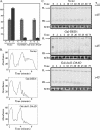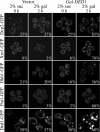The DEAD-box RNA helicase Ded1p affects and accumulates in Saccharomyces cerevisiae P-bodies
- PMID: 18162578
- PMCID: PMC2262982
- DOI: 10.1091/mbc.e07-09-0954
The DEAD-box RNA helicase Ded1p affects and accumulates in Saccharomyces cerevisiae P-bodies
Erratum in
- Mol Biol Cell. 2012 Jul;23(14):2818
Abstract
Recent results suggest that cytoplasmic mRNAs can form translationally repressed messenger ribonucleoprotein particles (mRNPs) capable of decapping and degradation, or accumulation into cytoplasmic processing bodies (P-bodies), which can function as sites of mRNA storage. The proteins that function in transitions between the translationally repressed mRNPs that accumulate in P-bodies and mRNPs engaged in translation are largely unknown. Herein, we demonstrate that the yeast translation initiation factor Ded1p can localize to P-bodies. Moreover, depletion of Ded1p leads to defects in P-body formation. Overexpression of Ded1p results in increased size and number of P-bodies and inhibition of growth in a manner partially suppressed by loss of Pat1p, Dhh1p, or Lsm1p. Mutations that inactivate the ATPase activity of Ded1p increase the overexpression growth inhibition of Ded1p and prevent Ded1p from localizing in P-bodies. Combined with earlier work showing Ded1p can have a positive effect on translation, these results suggest that Ded1p is a bifunctional protein that can affect both translation initiation and P-body formation.
Figures







References
Publication types
MeSH terms
Substances
Grants and funding
LinkOut - more resources
Full Text Sources
Molecular Biology Databases

